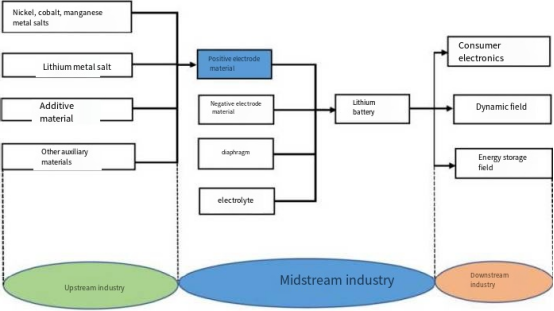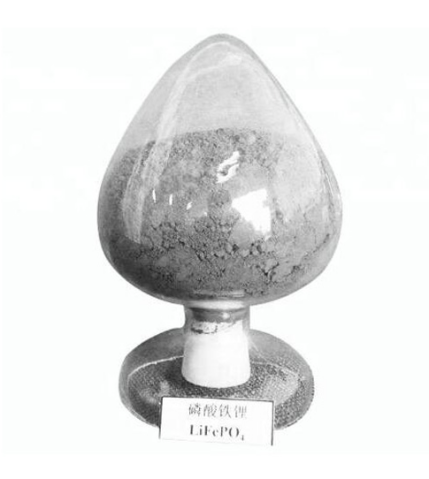Home > News
1、Introduction of lithium battery materials
The upstream of the lithium battery manufacturing industry is nickel, cobalt, manganese, lithium and other metal salts, additive materials and other auxiliary materials suppliers, the middle of the positive electrode material, negative electrode material, diaphragm, electrolyte and other materials manufacturers and lithium battery manufacturers, and the downstream of the industry is the terminal application field of lithium batteries. It is mainly in the field of power lithium batteries represented by electric vehicles, 3C lithium batteries represented by smartphones, and energy storage lithium batteries represented by communication base stations.

2、the cost of lithium batteries
Lithium battery is mainly composed of four parts: positive electrode material, negative electrode material, electrolyte and battery separator, of which the main cost is as follows:

3、positive electrode material
The performance of the cathode materialdirectly determines the energy density, life, safety, and application field of the battery, and its cost accounts for the highest proportion in lithium-ion batteries. Lithium battery cathode materials are mainly divided into lithium cobaltate, lithium manganate, lithium iron phosphate and ternary materials four types, four materials due to their respective characteristics of different applications in different markets. China has become one of the main manufacturing countries of lithium battery cathode materials in the world, among which, China has become the world's largest exporter of lithium cobalt acid and lithium manganese acid materials, and lithium iron phosphate and ternary cathode materials have become the world's largest production and use country.
(1)Lithium cobaltate: As the first generation of commercial lithium battery cathode material, lithium cobaltate has the advantages of high vibration density, stable charge and discharge, and high operating voltage, and is widely used in small rechargeable batteries. However, lithium cobaltate cathode materials have high cost (gold cobalt is expensive), poor cycling performance and poor safety performance, and have been replaced by terpolymer cathode materials in recent years. In the field of ultra-thin electronic products, lithium cobalt oxide cathode materials can not be replaced due to the advantages of good volume energy density and magnification performance. It is expected that lithium cobaltate cathode materials will develop in the direction of high voltage in the future.
(2) Lithium manganate: Lithium manganate is the earliest lithium battery cathode material studied in addition to lithium cobaltate, which has the advantages of rich resources, low cost and good safety performance; However, its low specific capacity and poor cycle performance, especially high temperature cycle performance, limit its application greatly. Lithium manganate batteries will mainly have a certain market share in logistics vehicles, as well as in the field of micro-passenger vehicles that focus on cost and have relatively low mileage requirements.
(3)Lithium iron phosphate: The emergence of lithium iron phosphate is a major breakthrough in lithium battery cathode materials, low price, environmentally friendly, high safety performance, good high temperature performance, so that it has formed a wider market application. However, its low energy density and poor low temperature performance are currently mainly used in the field of commercial vehicles (buses), and its application in the field of downstream passenger car power batteries is not as good as terene cathode materials with higher energy density.
(4)Ternary cathode material: the general molecular formula of ternary cathode material is Li (NiaCobXc) O2, where a+b+c=1, and the naming of the specific material is usually based on the relative content of the three elements. Where, when X is Mn, refers to nickel cobalt manganese (NCM) ternary material; When X is Al, it refers to the nickel cobalt aluminum (NCA) ternary material. The different proportions of the three elements make the ternary anode material produce different properties to meet the diversified application needs. Nickel-cobalt-manganese ternary material combines the advantages of lithium cobalt, lithium nickel-manganese and lithium manganate cathode materials, and has obvious ternary synergistic effect. Compared with cathode materials such as lithium iron phosphate and lithium manganate, terpolymer materials have higher energy density and longer driving range.

From the point of view of energy density, the theoretical specific capacity of lithium iron phosphate is lower than that of ternary material, but because ternary material battery requires a more complex battery management system, the difference in energy density between the two materials is reduced after the battery module is made. According to the three batches of new energy model catalogs released by the Ministry of Industry and Information Technology in 2021, the average module energy density of new energy passenger cars equipped with lithium iron phosphate batteries can reach 151.3Wh/kg; The average module energy density of new energy passenger cars equipped with terpolymer batteries can reach 164.7Wh/kg.
From a safety point of view, ternary materials usually self-heating above 180 degrees Celsius, decomposition occurs at about 200 degrees Celsius and releases oxygen, and the electrolyte burns rapidly at high temperatures, exacerbating the chain reaction. The safety performance of lithium iron phosphate is relatively good, the thermal phenomenon will occur above 250 degrees Celsius, the decomposition will occur at 700-800 degrees Celsius, and the decomposition will not release oxygen molecules, and the combustion is not as intense as the ternary material. Therefore, the safety of lithium iron phosphate cathode material is high.
From the manufacturing cost point of view, cobalt salt, nickel salt and lithium salt are the main raw materials for the preparation of ternary materials, of which cobalt salt and nickel salt in China's minable reserves are small, the supply is relatively tight, resulting in higher production costs of ternary materials. For lithium iron phosphate, the main raw materials are lithium source, iron source, phosphorus source, due to the rich resources of iron source and phosphorus source, lithium iron phosphate has a cost advantage.
Based on the above respective characteristics, in the field of new energy vehicles, lithium iron phosphate anode materials were mainly used in the field of new energy commercial vehicles in the early days. Ternary materials have a relatively high energy density and are mainly used in new energy passenger vehicles.
Contact: Lika
Phone: +86-19906035385
Tel: 0086-592-7161550
Email: sales@aotbattery.com
Add: No.168, Zhaogang Road, Xiamen City, China